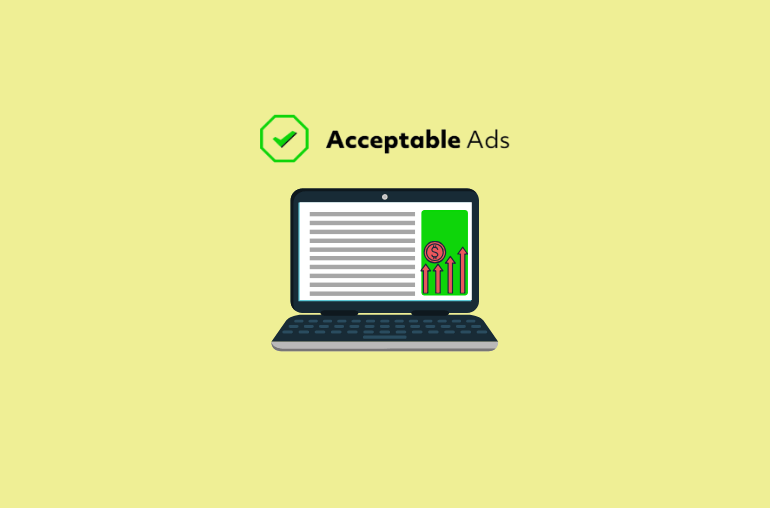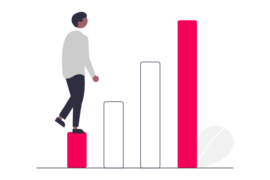Acceptable Ads provides a set of specifications to identify intrusive ads to show non-intrusive ones to ad blocking users. Here is everything you must know.
27% internet users across the globe block ads. Out of which, 48% do so to avoid seeing irrelevant and intrusive ads.
To solve this problem, Acceptable Ads reaches internet users and asks for their consent to which ad formats/types would they like to see across the web. As a result, there are 13,000 websites benefiting from Acceptable Ads.
What are Acceptable Ads?
Acceptable Ads defines guidelines to identify intrusive ads. Basically, these ads abide by criteria specifically designed for and by ad-blocking users. Acceptable Ads program has been launched and is maintained by eyeo, the company also behind AdBlock Plus.
eyeo surveyed over 150 million users who use ad blockers and asked them about ads that they consented to see/accept.
Why do we need Acceptable Ads?
To overcome the poor ad quality and avoid disruptive ads from the internet, users end up installing ad blockers. Because of bad ad experience, users get annoyed, advertisers lose on potential audience, and publishers miss out on their advertising profits.
Acceptable Ads bridges the gap between user choice and ad monetization. It allows non-disruptive ads to appear on a user’s screen, without hurting publisher’s ad revenue.
What is the Acceptable Ads Committee?
The Acceptable Ads Committee is the regulatory authority behind the tech, comprising over 40 companies, organizations, and individuals. It takes care of adding new standards and improving the existing ones by surveying users and conducting research.
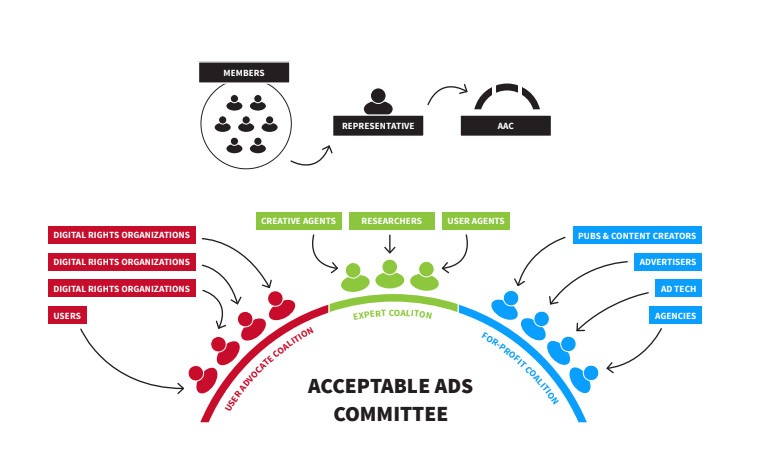
The committee is divided into three groups:
For-profit coalition – business stakeholders, including advertisers, ad-tech providers, advertising agencies, publishers, and content creators.
User advocate coalition – user-right defenders, digital rights organizations, and ad block users.
Expert coalition – specialist in online advertising and ad blocking—creative agents, researchers, and academics.
How’s it Different from Coalition for Better Ads?
| Coalition for Better Ads | Acceptable Ads | |
| Lead by | Coalition for Better Ads is launched by IAB, an organization responsible for developing industry standards, conducting research, and providing legal support for the online advertising industry. | Acceptable Ads is headed by eyeo, the same guys responsible for AdBlock Plus, an ad blocking extension for web browsers. |
| Objective | To develop global standards and to improve the current condition of online advertising by surveying users and asking experts. | To show ads to ad blocking users by pinning down the number of ad formats, sizes, and placement that are non-intrusive marked by them. |
| Regulating committee | – Standards and Research Committee – Communications and Awareness Committee – Accountability CommitteeTechnology Committee | – For-profit Coalition – User Advocate Coalition – Expert Coalition |
What are the Proposed Standards?
Acceptable ads committee advise publishers, ad networks, and ad tech agencies to comply with the standard.
The standards are divided in three categories to make it easy for everyone to understand:
1. Placement
Ads should not disrupt the natural reading flow. Placement standards allow ads to appear above, beside, and below the content. However, ads added between content will be treated as intrusive.
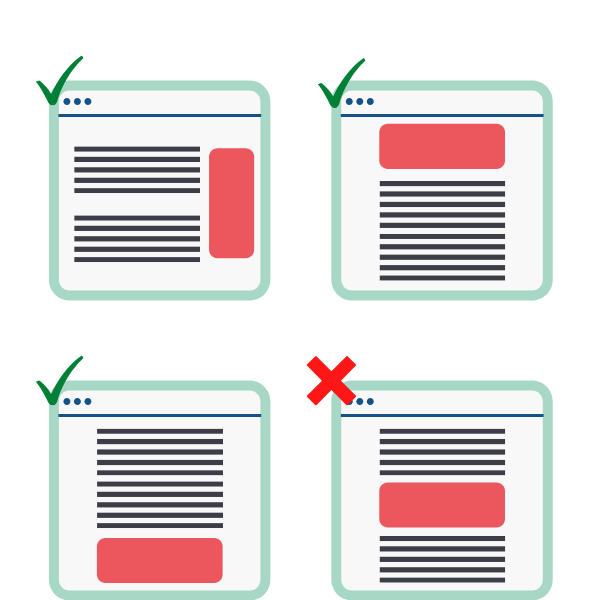
2. Distinction
Ads should be distinctive and clearly recognized as ads. For that, ads units must have labels like ‘advertisements’ or its equivalent added to them. This is to avoid misleading users into clicking on ads without knowing it—hurting advertisers budget and user’s experience.
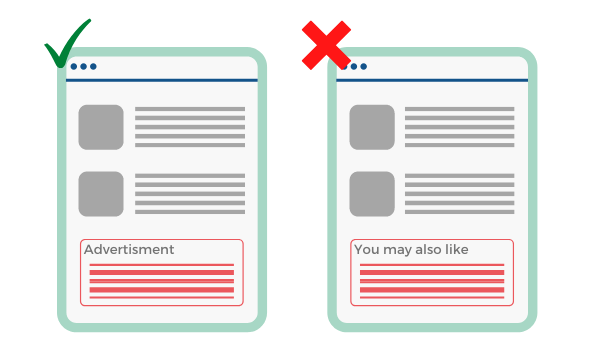
3. Size
Visible ads on screen must occupy 15% (px) or less screen in case of above the fold and 25% (px) or less in case of below the fold. Here are some strict size limitations:
- Ads above primary content should have height ≤ 200px
- Ads on the side of primary content should have width ≤ 350px
- Ads placed below the primary content should have height ≤ 400px
Specific Criteria
For Desktop
| Ad types | Specifications |
| Text ads (example: Google search ads) | Text ads shouldn’t have excessive use of colors and elements to grab attention. |
| Image ads (display/banner ads) | Static images are allowed, the intrusiveness of these ads types are decided based on their placement. |
| In-feed ads (presented in form of lists and feeds) | These ads are allowed between entries and feeds. In-feed ads should have size less than or equal to size of other feeds. |
| Search ads (ads displayed basis the user’s search query) | These ads are allowed to take up additional screen space. |
| Ads on page with no primary content | Only text ads are allowed with no size and placement limitations. |
For Mobile
| Criteria | Specifications |
| Size | Static ads (example: 6×1 banner and 1×1 tile ad): These can be placed anywhere on mobile pages.Small ads (example: 6×1 banner or smaller): Allowed to be placed as bottom sticky, while other sizes are not allowed for sticky.Large ads (ad height > 300px): Only allowed to be placed under primary content. |
| Placement | Ads shouldn’t occupy more than 50% of the viewportSticky ads have 75px (15%) height restriction. |
| Animation | Animations are allowed only in the form of bottom sticky for 6×1 ad sizes. It should comply with LEAN standards and have a close button or similar mechanism. |
Things Publishers Must Know Before Implementing Acceptable Ads
- Reinsertion OR Whitelisting:
Reinsertion technology ensures ad serving even when ad blocker is active. And Whitelisting marks that a company is fit to reinsert ads and abides by non-disruptive advertising practices. Publishers should know about the difference and similarities between these tech, before investing in it. Also check other ad block monetization solutions such as ad-lite, paywall/subscription, and more.
- Go for whitelisted partners:
Acceptable ads partners up with a few companies (including AdRecover) that are fit to reinsert ads and marks them whitelisted. If you, a publisher, are looking for ad block monetization, we recommend to choose the whitelisted companies and also get your own website/brand whitelisted (for which these companies can help).
- Ads will still be blocked:
The Acceptable Ads makes it possible to show a few (non-intrusive) ads. But there will still be a huge number of ad units that will be blocked because of active use of blockers. With acceptable ads, publishers can expect to regain lost revenue over ad blockers, however, the regained amount wouldn’t be as good as revenue generated without the use of ad blockers.
- Keep user experience in mind:
It is not recommended to get greedy with ad block monetization technology. Keep user experience and privacy in mind when choosing an ad block monetization solution. 71% online US population understands that publishers need to show ads to keep up with their free content, hence, building relationships with users should bring long-term benefits to business.
FAQs
Advertisements that are acceptable aren’t intrusive or annoying. They are respectful, don’t interfere with content, and are clearly labeled “advertisement.”
i. You can disable AdBlock by clicking the red stop sign icon in your browser.
ii. In the pop-up menu, click on the gear icon.
iii. Make sure “Allow Acceptable Ads” is unchecked.
iv. You can close the tab now.
The Acceptable Ads Committee (AAC) is a nonprofit organization that sets standards for what is and is not acceptable to show to Acceptable Ads users. Originally, it was envisioned in 2015 as a way for Acceptable Ads to be legislated by a committee independent of ad blockers.

Shubham is a digital marketer with rich experience working in the advertisement technology industry. He has vast experience in the programmatic industry, driving business strategy and scaling functions including but not limited to growth and marketing, Operations, process optimization, and Sales.
